Whole genome tests help teen twins get treatment for disease but won’t be widely used any time soon
- Share via
Much of what’s written about whole-genome sequencing -- testing to look at all the genes in a person’s DNA -- focuses on the big discoveries in genome research, the development of over-the-counter tests that can provide small bits of information about a person’s susceptibility to common diseases such as diabetes or heart disease, or the technology’s promise for personalizing medical treatments ... sometime in a vague, far-off future.
This week, physicians reported on a case where whole-genome testing helped them hit upon a correct diagnosis for 14-year-old twins who suffered from a muscular disorder -- and, significantly, use that information to refine the teens’ treatment and alleviate their symptoms. The research, published Wednesday in Science Translational Medicine, suggests that genetic tests will one day live up to their potential to help doctors treat patients, its authors wrote.
But an accompanying piece in the same issue of the journal explained why most of us shouldn’t expect that time to come right away.
The patients, 14-year-old twins Noah and Alexis Beery, were diagnosed with cerebral palsy when they were 2; when they were 4, it was discovered instead that they had a genetic disorder called dopa-resistive dystonia, which disrupts the body’s production of the neurotransmitter dopamine. At age 6 the kids started taking small doses of the medication L-dopa to treat the disorder. Before long, they were able to attend school and function as normal children, according to a news release from the Baylor College of Medicine, where first author Dr. Matthew Bainbridge conducted much of the work.
But when Alexis Beery began having trouble breathing a few years later, her parents (one of whom is an executive at a genetic sequencing technology firm in Carlsbad, Calif.) turned to further genome tests -- and the Baylor team -- to learn more about the kids’ mutations. The twins tested negative for the two genes known to cause dopa-responsive dystonia, but whole-genome tests turned up three other mutated genes that could have caused their disease. One of those genes was involved with the production of serotonin, another neurotransmitter. The doctors began treating the kids’ serotonin deficiency, and Alexis’ breathing troubles abated.
“The molecular diagnosis offered a refinement that enabled better medical management which could further alleviate symptoms and improve quality of life,” said coauthor Dr. James R. Lupski, in a statement. “It answers the question of why do the genome sequence.”
Still, problems remain with using such genome-wide sequencing to diagnose disease. The type of whole-genome test that can ferret out a rare disease-causing mutation in the midst of millions of DNA base pairs remains very expensive. In an accompanying perspective article, scientists Stephen F. Kingsmore and Carol J. Saunders noted that the cost of diagnosis through whole-genome assessments can exceed $10,000 per patient.
Costs are coming down, Kingsmore and Saunders wrote, but scientists have several hurdles to clear before such tests can be used on a broad scale. Researchers still need to develop a “clinical-grade general database of disease-associated mutations” as well as standards for interpreting genetic variants whose significance is unknown, they wrote. Also, the medical community needs to put more thought into genomic training programs for doctors and discussions of the implications of testing, they wrote.







